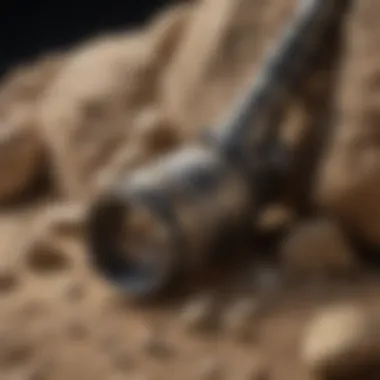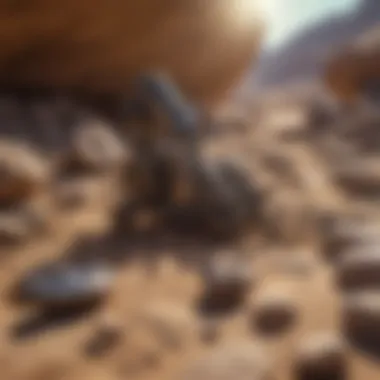Unleashing the Power of the Dremel 1000: A Complete Guide for Rock and Fossil Enthusiasts


Rock and Fossil Identification
The journey of exploring the versatile Dremel 1000 for rock and fossil collectors begins with a fundamental understanding of rock and fossil identification. Before delving into the intricacies of shaping and detailing, one must first grasp the different types of rocks and fossils that enrich collections. These geological treasures vary in composition, color, and texture, offering collectors a vast array of specimens to uncover the mysteries within. When seeking to identify rocks and fossils, key characteristics like mineral composition, fossil types, and unique patterns serve as guideposts in the exploration journey. Utilizing tools designed for identification, such as magnifying glasses, UV lights, and hardness picks, aids collectors in deciphering the intricate details and origins of their discoveries.
Collecting Tips and Techniques
Transitioning from identification to the art of collecting, rock and fossil enthusiasts navigate a realm brimming with best practices and techniques. In the quest for the perfect specimen, collectors are advised on the nuances of inspecting, handling, and preserving their finds. Locating prime collecting sites becomes a strategic pursuit, with geology maps, land permits, and local expertise guiding collectors towards hidden pockets of geological wealth. Extracting specimens safely from their natural habitats requires patience, precision, and a keen eye for preservation, ensuring that each rock and fossil retains its integrity throughout the collecting process.
Preservation and Display
As the collection grows in breadth and depth, the importance of preservation and display emerges as a pivotal aspect of the collector's journey. Techniques for preserving rocks and fossils delve into methods like cleaning, stabilizing, and sealing specimens to safeguard their natural allure. Finding the perfect storage solution becomes an art form, with considerations for humidity levels, temperature control, and protection from light influencing preservation choices. To bring these geological marvels to life, creative display ideas spark inspiration, from elegant shadow boxes to interactive museum-like exhibits that showcase the beauty and diversity of the rock and fossil collection.
Geological Insights
Beyond the tangible beauty of rocks and fossils lie profound geological insights that unravel the Earth's intricate tapestry. Exploring geological formations and processes unravels the stories etched in stone, from ancient sedimentary layers to volcanic eruptions frozen in time. The historical significance of rocks and fossils transcends mere artifacts, offering glimpses into paleontological discoveries, evolutionary milestones, and ancient climates. Notable discoveries in the field serve as testaments to human curiosity and scientific advancement, unveiling new chapters in Earth's history with each fossilized specimen unearthed.
Intro
In the realm of rock and fossil collecting, the Dremel 1000 stands out as a versatile and invaluable tool. With its myriad functions encompassing shaping, polishing, and detailing, this compact yet powerful device has revolutionized how collectors approach their craft. This article aims to unravel the intricacies of the Dremel 1000, providing rock and fossil enthusiasts with a comprehensive guide that elevates their collecting experience to new heights.
Overview of the Dremel
The history and development of the Dremel 1000 trace back to its origins, where innovation and precision merged to create a tool that redefined the possibilities within the collecting community. Understanding the evolution of this tool sheds light on its enduring popularity and utility. One key feature that sets the Dremel 1000 apart is its ergonomic design, allowing users to maneuver effortlessly through intricate projects, a quality that proves invaluable to collectors seeking precision and efficiency in their work.
Turning to the key features and specifications of the Dremel 1000, its versatility takes center stage. From variable speed settings to a wide array of compatible accessories, this tool caters to a diverse range of tasks, making it a go-to choice for rock and fossil collectors worldwide. While the compact size and lightweight nature of the Dremel 1000 enhance portability and ease of use, some users may find the lack of advanced features a limiting factor, especially when tackling more complex projects.
Significance in Rock and Fossil Collecting
Applications in Shaping and Carving
The applications of the Dremel 1000 in shaping and carving are truly transformative, enabling collectors to sculpt raw materials with precision and finesse. The ability to smooth rough edges and chisel intricate designs into rocks and fossils opens up a realm of creative possibilities, making this tool an indispensable asset in the collector's arsenal. While the Dremel 1000 excels in precision work, users must exercise caution to avoid over-carving or damaging their prized specimens during the shaping process.
Importance in Polishing and Detailing


When it comes to polishing and detailing, the Dremel 1000 shines as a beacon of quality and efficiency. Its unrivaled capacity to enhance natural patterns and achieve a glossy finish elevates the aesthetic appeal of collected specimens, allowing collectors to showcase their treasures in all their splendor. However, operators should exercise patience and skill when engaging in detailed work, as an overly heavy hand may result in unintended damage or alteration to the material's surface.
Getting Started with the Dremel
As we embark on our journey to delve deep into the world of rock and fossil collecting with the Dremel 1000, the pivotal starting point lies in understanding how to effectively utilize this versatile tool. Getting started with the Dremel 1000 is not merely a mundane task but a gateway to unlocking a realm of possibilities in shaping, polishing, and detailing your prized collection. This section will shed light on the essential components and safety measures necessary to maximize the potential of the Dremel 1000.
Assembling the Dremel
Attaching Accessories
When it comes to the intricate art of attaching accessories to the Dremel 1000, precision is key. Each accessory serves a distinct purpose, whether it be for shaping, carving, or polishing rocks and fossils. The seamless attachment of accessories ensures smooth operation and optimal performance of the tool. By exploring the various attachments available for the Dremel 1000, rock and fossil collectors can tailor their tools to suit their specific crafting needs, thereby enhancing the overall collecting experience.
Understanding the Components
Delving into the inner workings of the Dremel 1000 unveils a world of intricate components that contribute to its functionality. From the motor to the collet, each component plays a vital role in ensuring the tool operates smoothly and efficiently. Understanding these components not only facilitates ease of use but also equips collectors with the knowledge needed to troubleshoot any potential issues that may arise. By grasping the nuances of these components, rock and fossil enthusiasts can harness the full potential of the Dremel 1000 in their creative pursuits.
Safety Precautions
Protective Gear Essentials
Prioritizing safety in any rock or fossil carving endeavor is paramount, and selecting the right protective gear is non-negotiable. Safety goggles, dust masks, and gloves are not mere accessories but shields against potential hazards. Investing in quality protective gear not only safeguards your well-being but also allows for uninterrupted focus on honing your craft. By integrating protective gear essentials into your rock and fossil collection routine, you pave the way for a secure and fulfilling crafting experience.
Operating Guidelines
Operating the Dremel 1000 demands adherence to a set of meticulous guidelines to ensure both user safety and machine longevity. From proper handling techniques to ideal operating speeds, following these guidelines is imperative for achieving optimal results. Understanding the intricacies of operating the Dremel 1000 not only mitigates risks but also enhances efficiency in rock and fossil crafting. By abiding by these guidelines, collectors can elevate their artistry and preserve the lifespan of their trusted tool.
Utilizing the Dremel for Rock and Fossil Collecting
The importance of utilizing the Dremel 1000 for rock and fossil collecting cannot be overstated in this comprehensive guide. With its versatile features and precision, the Dremel 1000 offers rock and fossil enthusiasts a plethora of applications that significantly enhance their crafting endeavors. From shaping rough stones to intricate detailing work, the Dremel 1000 is a game-changer in the world of rock and fossil collecting.
Rock Shaping and Carving Techniques
Smoothing rough edges


Smoothing rough edges is a fundamental aspect of rock shaping and carving with the Dremel 1000. This technique plays a crucial role in refining the contours of rocks and fossils, ensuring a professional finish. The key characteristic of smoothing rough edges lies in its ability to transform jagged surfaces into smooth, polished features with remarkable precision. Utilizing this technique eliminates sharp edges, making the stones safer to handle and more aesthetically pleasing. However, it requires patience and a steady hand to achieve optimal results without over smoothing the surface.
Creating intricate designs
The art of creating intricate designs elevates rock and fossil crafting to a whole new level of sophistication. This technique enables enthusiasts to carve detailed patterns and motifs on stones, imparting a unique aesthetic appeal. The key characteristic of creating intricate designs lies in the meticulous attention to detail and craftsmanship involved in producing elaborate artworks. While this technique allows for immense creativity and personal expression, it also demands precision and focus to execute complex designs successfully. Incorporating intricate designs into rock and fossil pieces enhances their visual impact and sets them apart as exquisite collectible items.
Polishing and Detailing Tips
Enhancing natural patterns
Enhancing natural patterns through polishing is a transformative process that brings out the inherent beauty of rocks and fossils. This technique accentuates the geological features and unique textures present in the specimens, resulting in visually stunning displays. The key characteristic of enhancing natural patterns is its ability to reveal hidden details and intricacies within the stone, showcasing its natural beauty. By carefully polishing the surfaces, collectors can create captivating contrasts and highlights that enhance the overall aesthetic appeal of their specimens.
Achieving a glossy finish
Achieving a glossy finish is a final touch that adds a professional sheen to rock and fossil creations. This technique involves buffing the surfaces to a high shine, creating a lustrous appearance that enhances the visual allure of the specimens. The key characteristic of achieving a glossy finish lies in the reflective quality it imparts to the stones, making them appear polished and refined. While this technique enhances the overall presentation of the collectibles, it requires meticulous attention to detail to avoid over polishing and maintaining a uniform gloss across the surfaces.
Maintenance and Care of the Dremel
In this segment of the article focusing on the Dremel 1000, we delve into the critical aspect of maintenance and care. Understanding the nuances of properly looking after your Dremel 1000 is paramount to ensuring its longevity and optimal performance. This section aims to equip rock and fossil collectors with essential knowledge on preserving their tool investment.
Cleaning and Storage
Proper maintenance practices
Exploring proper maintenance practices is fundamental in guaranteeing the efficacy and durability of your Dremel 1000. By adhering to these practices, users can significantly prolong the lifespan of their tool, ultimately enhancing its performance outcomes. The meticulous cleaning approach not only eradicates debris buildup but also safeguards the intricate components within the Dremel 1000, maintaining its functionality over time. Embracing proper maintenance practices is a prudent decision for any enthusiast seeking consistent and reliable results in their rock and fossil crafting endeavors.
Storage recommendations
The significance of appropriate storage solutions cannot be overstated when it comes to the Dremel 1000. Suitable storage practices shield the tool from environmental elements, moisture, and potential damage, ensuring its integrity between uses. Opting for well-ventilated storage that is devoid of humidity is crucial in preventing corrosion and preserving the tool's performance quality. Implementing these storage recommendations is a proactive measure that underscores the commitment to caring for your Dremel 1000, safeguarding its functionality for the long haul.
Troubleshooting Common Issues
Overview of the black oxite top hat FR204G - Inv. nr. JSONG8334728


Troubleshooting common problems with the Dremel 1000 is integral for enthusiasts aiming to maximize their tool's potential. By navigating through these challenges adeptly, users can maintain peak performance levels and sustain the efficiency of their tool. Addressing issues such as overheating demands a meticulous approach, incorporating preventative measures to avert potential malfunctions. Similarly, understanding the process of replacing worn-out parts is essential in maintaining the optimal functionality of the Dremel 1000. By comprehensively troubleshooting common issues, collectors can elevate their crafting experience and ensure seamless operations with their tool.
Exploring Advanced Techniques with the Dremel
Diving into the realm of advanced techniques with the Dremel 1000 marks a pivotal juncture in this comprehensive guide for rock and fossil collectors. It is imperative to comprehend the nuanced aspects of employing the Dremel 1000 beyond basic functions. This section encapsulates an array of intricate methods that elevate the craftsmanship of rock and fossil manipulation, providing enthusiasts with a spectrum of creative possibilities.
Intricate Engraving Methods
Fine Detailing on Rocks and Fossils
The niche domain of fine detailing on rocks and fossils truly embodies the essence of precision and artistry within the purview of rock and fossil collecting. Delving into the minutiae of textures, lines, and formations, this facet accentuates the raw beauty encapsulated within each geological specimen. The meticulous attention to detail imbues a sense of sophistication and refinement, enriching the overall aesthetic appeal of the collection. This meticulous process demands patience, dexterity, and a keen eye for intricacies, culminating in unparalleled visual allure characteristic of fine detailing on rocks and fossils.
Personalizing Your Collection
Personalization stands as an indispensable facet in the realm of rock and fossil collecting, enabling enthusiasts to infuse their unique identity into each piece. Tailoring specimens with personal insignias, initials, or custom motifs not only adds a sentimental touch but also transforms the collection into a reflection of one's artistic expression. The ability to personalize empowers collectors to foster a deeper connection with their acquisitions, rendering each piece not just an object but a narrative of personal significance. However, it is vital to strike a balance between personalization and preservation of the inherent integrity of the rocks and fossils to uphold their intrinsic charm.
Artistic Applications
Creating Custom Display Pieces
The creation of custom display pieces signifies a paradigm shift in conventional rock and fossil exhibition, ushering in a wave of creativity and innovation. Crafting bespoke stands, mounts, or showcases tailored to each specimen amplifies their visual impact and orchestrates a harmonious presentation. Custom display pieces not only accentuate the grandeur of the rocks and fossils but also provide a platform for storytelling, enabling collectors to curate narratives around their prized possessions. Through thoughtful design and execution, custom displays immortalize the beauty and significance of each specimen, elevating the collection into a veritable objet d'art.
Experimenting with Textures
Embarking on an odyssey of texture experimentation elucidates the boundless possibilities inherent in rock and fossil manipulation. Texture serves as a pivotal element in evoking sensory responses, adding depth and dimension to the collection. By exploring diverse textures through carving, etching, or embossing techniques, collectors can imbue their specimens with a tactile allure, inviting tactile exploration. Navigating the realm of textures cultivates a richer appreciation for the intrinsic qualities of rocks and fossils, turning each piece into a tactile canvas awaiting discovery and admiration.
Epilogue
To conclude this in-depth exploration of the Dremel 1000, we must address the pivotal role of this tool in elevating the rock and fossil collecting experience. Throughout this guide, we have uncovered the multifaceted capabilities of the Dremel 1000, transforming how collectors approach shaping, polishing, and detailing their treasured finds. By mastering the art of utilizing this versatile tool, enthusiasts can unlock a new level of creativity and precision in their craft. The Dremel 1000 serves as a bridge between imagination and realization, offering a canvas for individuals to sculpt and refine their collections with finesse. As collectors delve into the intricate world of rock and fossil manipulation, the Dremel 1000 stands as a reliable companion, aiding in the transformation of raw specimens into exquisite pieces of art.
Enhancing Your Collecting Experience
Final thoughts on the Dremel
Delving into the final reflections on the Dremel 1000 unveils a world of precision and efficiency for rock and fossil enthusiasts. This indispensable tool offers a seamless blend of power and control, enabling collectors to unleash their creativity with unparalleled ease. The ergonomic design of the Dremel 1000 ensures comfort during extended usage, allowing for a steady hand and impeccable detailing. Its versatility in tackling various rock and fossil materials makes it a preferred choice among seasoned collectors seeking optimal results. Despite a few minor drawbacks such as minor vibrations during operation, the Dremel 1000 remains a top contender in the toolkit of rock and fossil aficionados.
Incorporating it into your workflow
Integrating the Dremel 1000 into your workflow opens up a realm of possibilities for rock and fossil collectors. Its seamless compatibility with a wide range of accessories empowers users to customize their tools based on specific project requirements, enhancing efficiency and precision. The effortless transition between different tasks, from shaping to polishing, streamlines the creative process, allowing for uninterrupted workflow. The compact nature of the Dremel 1000 ensures easy storage and accessibility, making it a practical addition to any collector's workspace. While occasional maintenance to address wear and tear is necessary, the benefits of incorporating the Dremel 1000 into your workflow far outweigh minor maintenance considerations.







